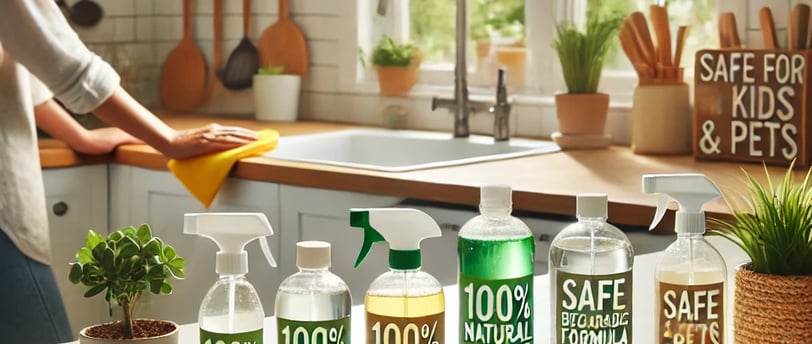The Hidden Dangers of Using Harsh Cleaning Chemicals
Harsh cleaning chemicals pose serious health and environmental risks, making eco-friendly alternatives better, more practical, and safer for a clean, healthy home.


Many household cleaning products promise a sparkling, germ-free environment, but at what cost? Hidden within these solutions are chemicals that pose risks to human health, pets, and the environment. Studies have linked common cleaning agents to respiratory issues, skin irritation, hormonal disruption, and environmental contamination. This blog will explore the dangers of harsh cleaning chemicals and how switching to eco-friendly alternatives can create a safer, healthier home.
1. Toxic Fumes: The Hidden Airborne Threat
Many conventional cleaning products contain volatile organic compounds (VOCs), which can release harmful fumes into the air. These compounds contribute to indoor air pollution, leading to respiratory problems, headaches, and long-term health risks.
Scientific Findings:
A 2018 study published in Science Advances found that household cleaning products are a significant source of VOC emissions, comparable to car exhaust (McDonald et al., 2018).
According to the American Lung Association, exposure to VOCs can trigger asthma attacks and cause chronic respiratory issues, particularly in children and individuals with pre-existing conditions (ALA, 2022).
Eco-Friendly Solution:
Switching to plant-based, non-toxic cleaning products reduces indoor air pollution. Look for certified eco-friendly labels such as EPA Safer Choice or Green Seal, which ensure products meet strict health and environmental standards.
2. Skin Irritation: Hidden Dangers in Everyday Cleaners
Many cleaning agents contain harsh surfactants and synthetic fragrances that strip moisture from the skin, causing irritation, redness, and, in severe cases, chemical burns.
Harmful Chemicals to Watch For:
Sodium hypochlorite (bleach) Can cause severe skin burns and eye damage (CDC, 2021).
Ammonia: Often found in glass cleaners, ammonia exposure can lead to chemical burns and worsen respiratory conditions (OSHA, 2020).
Fragrance additives: Many artificial fragrances contain phthalates, which are known endocrine disruptors linked to reproductive issues (National Institute of Environmental Health Sciences, 2022).
Safer Alternatives:
Vinegar and baking soda make excellent natural alternatives for surface cleaning.
Castile soap, made from vegetable oils, cleans effectively without irritating the skin.
Opt for fragrance-free or naturally scented products derived from essential oils like lavender or lemon.
3. Environmental Impact: The Ripple Effect of Harsh Chemicals
When cleaning chemicals are rinsed down drains, they can enter waterways, polluting rivers and oceans. Many conventional products contain phosphates, contributing to water pollution and disrupting aquatic ecosystems.
Scientific Evidence:
A report by the U.S. Environmental Protection Agency (EPA) found that phosphates in detergents lead to algal blooms, which deplete oxygen in water bodies, endangering fish and marine life (EPA, 2023).
The World Wildlife Fund (WWF) highlights that microplastics from scrubbing agents in some cleaners persist in water sources, harming aquatic species (WWF, 2021).
How to Reduce Environmental Damage:
Use biodegradable cleaning products that break down safely in the environment.
Choose brands that offer recyclable or reusable packaging to minimize waste.
Opt for refillable cleaning products to cut down on plastic pollution.
4. Child and Pet Safety: Protecting Vulnerable Family Members
Children and pets are particularly susceptible to harmful chemicals due to their smaller size and tendency to explore their environment through touch and taste.
Statistics and Research:
The National Poison Data System (NPDS) reported that household cleaning products accounted for over 10% of all poison exposures in children under five in 2021 (NPDS, 2021).
Research from the American Veterinary Medical Association (AVMA) indicates that chemicals like phenols, often found in disinfectants, are highly toxic to pets, especially cats (AVMA, 2022).
Safer Cleaning Methods for Families and Pets:
Use pet-safe floor cleaners since pets lick and walk on surfaces frequently.
Keep cleaning products stored out of reach of children and animals.
Choose hypoallergenic, non-toxic products labeled safe for kids and pets.
5. Long-Term Health Risks: The Hidden Costs of Chemical Exposure
Scientific studies have linked prolonged exposure to certain cleaning agents with severe health conditions, including hormonal imbalances, cancer, and neurological disorders.
Notable Findings:
A longitudinal study published in the American Journal of Respiratory and Critical Care Medicine in 2018 found that regular exposure to cleaning sprays increased lung decline risk, equivalent to smoking 20 cigarettes a day (Svanes et al., 2018).
The Endocrine Society has identified common cleaning chemicals like triclosan as endocrine disruptors that may contribute to hormone-related cancers (Endocrine Society, 2020).
How to Minimize Risk:
Switch to plant-based, non-toxic cleaners that avoid synthetic preservatives and harmful disinfectants.
Improve ventilation when using any cleaning product to reduce inhalation exposure.
Wear protective gloves and masks to minimize skin and respiratory contact with chemicals when cleaning.
Making the Switch to Healthier Cleaning Practices
Choosing eco-friendly cleaning products protects your health and contributes to a healthier planet. Here’s how you can transition to safer cleaning practices:
What to Look for in Eco-Friendly Cleaners:
✅ Third-party certifications: Look for Green Seal, EcoLogo, or EPA Safer Choice labels.
✅ Non-toxic ingredients: Opt for products with natural ingredients like vinegar, citrus extracts, and coconut-based surfactants.
✅ Sustainable packaging: Choose brands that offer recyclable, compostable, or refillable packaging.
✅ Transparency: Look for companies that disclose all ingredients on their labels.
Conclusion: A Cleaner, Healthier Home Starts with You
Harsh cleaning chemicals may offer short-term results, but their long-term effects on health and the environment are too significant to ignore. Switching to non-toxic, eco-friendly cleaning solutions is an easy and impactful way to protect your family, pets, and planet.
At Speckless, we are committed to using safe, effective, and environmentally responsible cleaning products that ensure a fresh and healthy home without the risks associated with harsh chemicals.
Ready to Make the Switch?
Contact Speckless today for eco-friendly cleaning services prioritizing health, safety, and sustainability! Call us now

